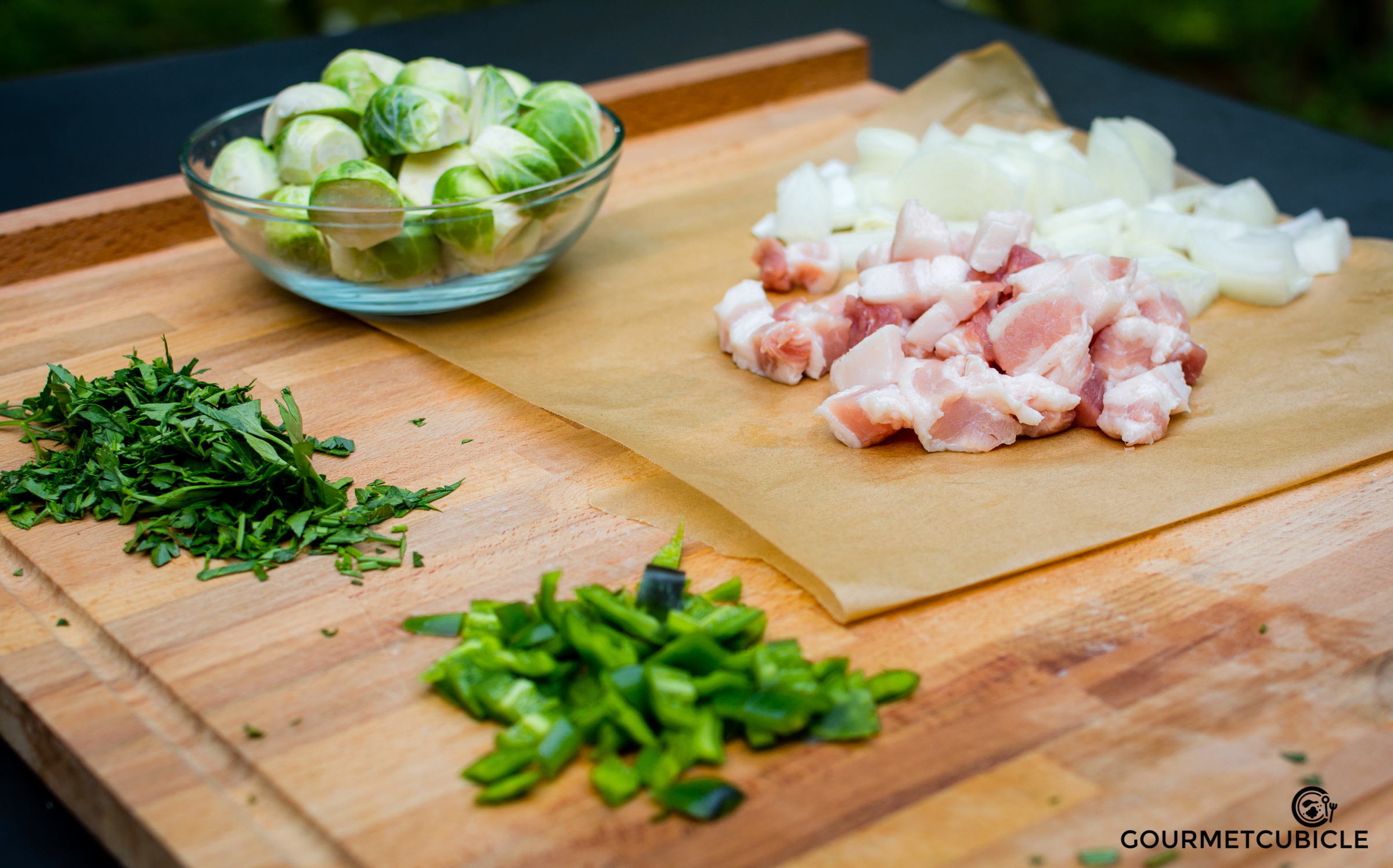Pork Belly and Oyster Mushroom Potato Hash
The time has come for me to post a heartier and manlier dish here on gourmetcubicle. As of late, I committed to getting back in shape by losing the extra weight I gained during my business trip. I picked up running again and, for the first time since college, I started lifting weights. Getting enough exercise has never been a concern of mine though, as I've always been active, either playing soccer in Zilker Park or volleyball on various leagues around town. The biggest challenge for me when it comes to losing weight is to hold back from eating so much. I severely lack discipline in the kitchen.
I love carbs. It doesn't matter if it's pasta, fresh crispy breads or starches, I embrace them all. I like to blame my weakness for carbs on the Romanian and Hungarian food culture. Bread and potatoes are two things that are never missing from the dining table. Abundance is the word that best describes both these cuisines. You'll never walk out of the house of a Romanian or Hungarian feeling hungry or anything short of being completely full.
It all comes down to our culture of hospitality, and Romanians take hospitality extremely seriously. We greet our guests and visitors with fresh baked bread and salt. It's a tradition that dates back to before Christianity and it is seen as a symbol of acceptance and kindness. But why two simple things like bread and salt, you may ask? Well, bread was the main source of food representing the wealth of the fields for the peasants, whereas salt, for a long time in history, was one of the most expensive and valuable assets in trading.
Fun Fact: the word companion, which is defined as a person or animal one shares significant time with, comes from Latin and has at its roots the words com- meaning "with" in English, and panis, which is "bread".
Moving on to our recipe today, this is a dish so versatile that you can serve it for breakfast, brunch or even dinner. It is a savory, flavorful and filling dish, easy enough to be prepared even by a beginner cook. The pork belly can be substituted with bacon if that's something that is more accessible, and the brussels sprouts can be replaced by broccoli florets of roughly chopped cabbage. Enjoy!
PORK BELLY AND OYSTER MUSHROOM POTATO HASH
Serves 4
Prep time: 10 minutes
Cook time: 45-50 minutes
Ingredients
- 1 lb pork belly, cut into 1/2 inch pieces
- 1/2 tsp black pepper, freshly ground
- 1/2 tsp kosher salt
- 2 TBS sunflower seed oil (or peanut)
- 1 yellow onion, roughly chopped
- 2-3 jalapeños, sliced (remove seeds and membrane for milder version)
- 1 1/2 lbs medium potatoes, unpeeled and diced into 1 inch pieces
- 1 tsp kosher salt
- 1 tsp black pepper, freshly ground
- 1 tsp smoked paprika
- 3/4 lb brussels sprouts, cleaned and halved
- 4-5 green onions, roughly chopped
- 1 lb oyster mushrooms, rinsed
- 1 TBS unsalted butter
- 1/2 medium lemon juiced (about 1-2 TBS fresh lemon juice)
- 1/4 cup fresh parsley, finely chopped
- 4 eggs, pasture raised
- 1/4 cup fresh parsley, finely chopped (for garnish)
- 1 tsp smoked paprika (for garnish)
- salt, to taste
Instructions
- Sprinkle the pork belly with salt and pepper.
- Heat one tablespoon oil in an oven proof cast iron or stainless steel skillet over medium-high heat. When the oil is shimmering, add pork belly and cook for about 10 minutes until the bits become crispy and golden brown. Stir occasionally.
- Remove the pork bites from the pan and transfer them to a paper towel lined plate or a wire rack. Add the rest of the oil to the skillet.
- Preheat oven to 400F (200C) degrees.
- Add onion to the skillet carefully. Be careful not to toss it in because you risk getting burned by the splattering oil. Cook for 3 minutes. Add jalapeños and cook for another 2 minutes. Add potatoes and sprinkle with salt, pepper and one teaspoon smoked paprika. Continue cooking for 5 more minutes stirring every now and then. Add the brussels sprouts. Cook for 10 minutes and then add green onions, mushrooms, butter, lemon juice and quarter cup parsley (half of the total amount). Cook for 5-7 more minutes. Toss and stir occasionally.
- Remove skillet from the heat. Toss in the pork belly bits and gently stir. Crack the eggs on top of the hash and place the skillet in the oven. Cook for 10-15 minutes until the eggs are cooked to your favored consistency. 10 minutes baking will yield a runny egg (my favorite) whereas 15 minutes will get the egg cooked all the way through.
- Sprinkle with the rest of the parsley and smoked paprika. Taste and adjust saltiness. Serve hot.













